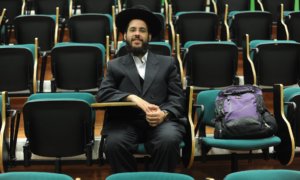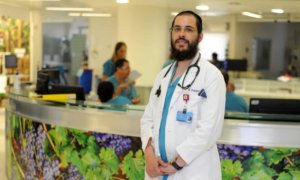
Traditionally, Haredi men have not joined the labour force. That is starting to change.

Medical student Yehuda Sabiner in class: ‘In the end 99% of people were encouraging me.’ Photograph: Rami Shlush
From the age of three, Yehuda Sabiner harboured a secret ambition to become a doctor. But it seemed unlikely to be fulfilled: he was raised in one of the strictest ultra-Orthodox Jewish communities in Israel.
His education was limited to religious study, first at a private school that barely taught mainstream subjects and later at a yeshiva, a religious school, where he spent 14 hours a day studying Jewish texts. Sabiner, a bright boy and an outstanding student, was earmarked to become a leading rabbi.
But he never forgot his dream. When he was 21 he confessed his ambition to his new wife. She was horrified: she had married him on the understanding that he would be a rabbinical leader. Also, he had no knowledge of science. But Sabiner’s yearning would not go away.
Now 28, Sabiner is embarking on the final year of his medical degree. He will be the first person born and raised in a Haredi community in Israel to become a mainstream doctor, and he plans to specialise in internal medicine.
Sabiner has benefited from a pioneering scheme at the Technion university in Haifa to draw young ultra-Orthodox, or Haredi, Jews from largely closed communities into mainstream education and then into the workforce.
The numbers are still tiny – about 60 out of a total student population of 10,000. “But the idea is to bring the number to 200 within five years, and to 400 within 10 years,” said Prof Boaz Golani, a vice-president of the university. “Engaging the Haredi community is important for Israel. Having a civil society where entire segments live in their own world and with little interaction with others is not healthy. It’s a recipe for tension and animosity.”
In 2017 the number of ultra-Orthodox Jews in Israel rose above one million for the first time, accounting for 12% of the population. By 2065 they are expected to make up a third of Israel’s population.
Traditionally, Haredi men are not economically active. Many spend their time in religious study, relying on state benefits to support their large families, which average almost seven children. But in recent years the Israeli government and educational institutions have taken steps to integrate the Haredi population into colleges and workforces.
“There was a concentrated effort launched a few years ago by the ministry of transport, which needed more engineers,” said Golani. If the Technion could get Haredi students on to its courses, jobs could be guaranteed.
“We knocked on the doors on yeshivas in Bnei Brak [an overwhelmingly ultra-Orthodox town near Tel Aviv]. We found a few rabbis ready to talk to us. The idea was to take young men who had the brain and intellect to meet the scientific admission criteria, and who were not perceived as chief rabbis of the future.
“We said we would not try to force any change of lifestyle of students, such as [strict] dress codes or praying. We kept a low profile.”
The Technion team identified 37 young men for a pre-university programme run from an anonymous rented warehouse in Bnei Brak. Over the course of 18 months, teachers tried to close a 12-year education gap to bring the Haredi men up to the standard of high school graduates.
They studied from 8am to 10pm. “It was like a bootcamp, very intensive,” said Golani. “But they brought from the yeshivas an ability to study hard, to focus, to apply logic, so we built on these skills.” At the end of the programme, about half were admitted to the Technion; they graduated this summer.
Bringing the students up to the required educational standard was not the only challenge. Gender segregation, a norm in Haredi communities, was a big issue, Golani said. “We told them upfront that we would not allow gender segregation on campus, no way. We suggested they arrive at class 10 minutes early and sit together, and they accepted that. We also told them that we have female professors, and we will not tell them they can’t teach certain students. They accepted that too.”
Another key issue was use of the internet. “So each [Haredi student] carries two phones: a kosher phone, with no apps, and a regular smartphone. On that there is an app which tracks the history of all addresses browsed and sends a report of every website visited to a designated person in their community.”
Some students have been ostracised by their communities. “One girl was boycotted by her friends. Someone else told me he was hiding for years, lying to his wife and family, telling them he was studying at another yeshiva when he was at the Technion.”
The university also runs programmes aimed at encouraging Arab students to enrol. “That tends to be easier because their communities are eager to see them gain top-quality education and so the community resistance is much lower,” said Golani.
It was essential to integrate “untapped resources” – meaning Arab-Israelis and ultra-Orthodox Jews – into the economy, he added. “The economy of Israel is largely based on the hi-tech sector. It’s the locomotive that carries the entire train of the Israeli economy. But we just don’t have enough people. Israel is a small country; we’re not India or China.”

Sabiner is now in the final year of his medical degree. Photograph: Rami Shlush.
When Sabiner embarked on the challenge of becoming a doctor, initially he faced scepticism. “I was told it was impossible for me to catch up [academically] and to be accepted, that I would never make it as a doctor,” he said. But staff at the Technion “believed in me when no one else did”.
Article by Harriet Sherwood, published in The Guardian, 10 September 2018.
